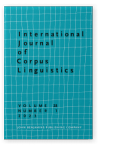Vol. 28:1 (2023) ► pp.60–90
The rise of colligations
English can’t stand and German nicht ausstehen können
This article examines the lexically parallel English and German constructions can’t stand somebody/something and jemanden/etwas nicht ausstehen können “not tolerate (someone or something)”, from synchronic, diachronic, and quantitative perspectives. Syntactic and semantic restrictions suggest that the usage of stand and ausstehen in the relevant sense is older than other semantically similar verbs (e.g. English tolerate, German leiden), while quantitative evidence from corpora shows that the can’t stand and nicht ausstehen können constructions are both colligationally stronger than lexical competitors. Evidence from the history of stand indicates that the lexeme stand in the Germanic and other Indo-European languages has a long history of being employed in the relevant sense. The restrictions on usage and the colligational strength of the respective English and German constructions are thus argued to result from the antiquity of the construction and functional competition from other lexemes.
Article outline
- 1.Introduction
- 2.Synchronically and diachronically conditioned colligations
- 2.1Synchronic colligational restrictions
- 2.2The diachronic conditioning of colligations
- 2.2.1Lexical renewal and competition induce linguistic specialization via colligation
- 2.2.2Diachronically persistent parameters motivate blocking effects and colligations
- 3.Colligations, restrictions, and the linguistic age of E. stand and G. ausstehen
- 4.Colligations in English can’t stand and German nicht ausstehen können
- 4.1 English: (can’t) stand someone/something (out)
- 4.2German: From (ir)stan(tan) to nicht ausstehen können
- 4.3Summary of attested diachronic developments
- 5.Quantitative analysis of colligations, cohesion, and linguistic age
- 5.1Collostructional analysis and constructional productivity
- 5.2Colligational strength in the can not verbinf x
0
objectacc
construction: Data collection and quantitative analysis
- 5.2.1English
- 5.2.2German
- 6.Conclusion
- Notes
- The following abbreviations are employed in this article
-
References
For any use beyond this license, please contact the publisher at [email protected].
